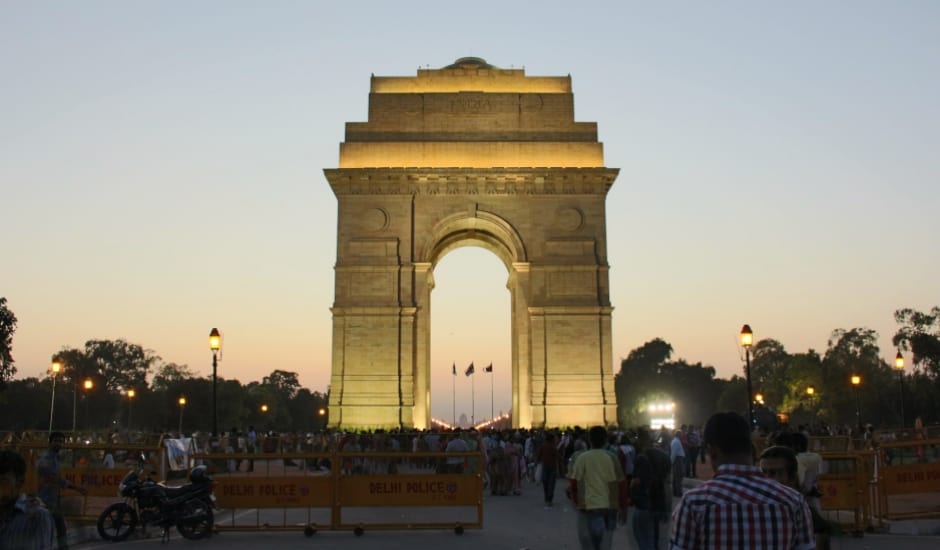The last of my big four reasons for coming on the trip to China and India (after the Great Wall of China, the Terracotta Army and the Taj Mahal), was the opportunity to see tigers in the wild.
I’d done a lot of research, including talking to a friend who’d gone on three safaris and not seen any tigers, so I had an idea of what I was in for. The Indian Government website allowed you to select the zone in the park you wanted to visit and the type of vehicle you wanted to take, but I couldn’t get it to take my payment details. And I had limited knowledge of which zone I wanted to visit – all I knew is that I wanted to take the Jeep (gypsy) not the truck (canter).
I noticed in my research someone mentioning that foreigners couldn’t book the safaris online, so resigned myself to booking through one of the hotels that provided this service. Lo and behold, I found a lot with 300% mark ups. So we’re talking about £50 per safari. So then I did a search for the Government rate – ₹1750 at the time (for a gypsy – now ₹2250), and up came the Rhanthambor Regency.
I had a look at the reviews and I couldn’t find anything that concerned me, so I emailed them with my requirements and mentioned that I belonged to IATA (International Air Transport Association – a travel association I belonged to as a result of working for TripAdvisor at the time). They offered a discounted rate and confirmed their safari rate and so I booked two nights and three safaris with them. Breakfast and dinner were also included.
I was dropped off by my driver in the early evening and made arrangements to be picked back up in two days time at noon to continue my trip to Jaipur. Checking in was a breeze, though there was the usual pause at the visa dates (see: Arrival in Delhi) and I was shown to my room.
The room itself was a good size, with a large comfortable bed and air-con. I went down to the dining room and helped myself to the buffet. There was a naan oven just outside the dining room with a couple of the staff sitting and chatting, and as I sat down with my plate one of them came jogging over to me, theatrically tossing a piece of freshly baked naan from hand to hand to illustrate its hotness and freshness from the oven.
They must have put it on as soon as I arrived and made a big show of delivering it. As I was one of the first ones in the dining room I was the only audience to the show but I appreciated the gesture and gave a big grin.
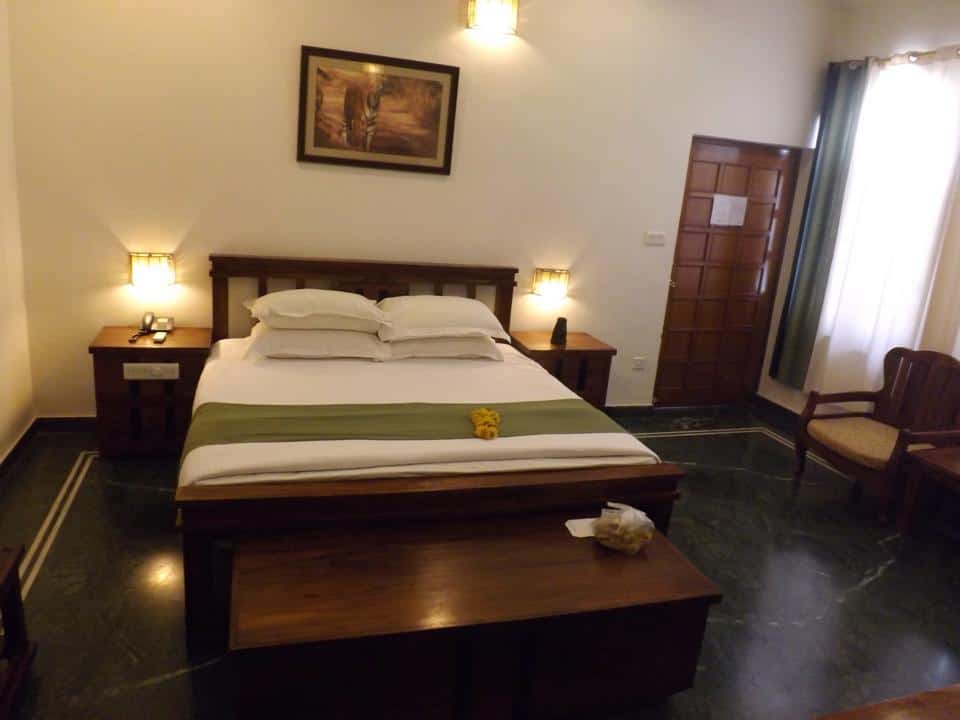
The food itself was great – each dished labelled clearly and indications on which were hot and which not, which I was very appreciative of – I’m not known for my capacity with spices! There was a selection of non-Indian dishes but I couldn’t pass up the local delicacies. Although I did avoid the fish – I’m sure it was fresh from a local lake or river, but I didn’t want to risk my safaris on getting that wrong. Beer and wine weren’t included in the room rate, so I availed myself of one of the juices on offer instead. Suitably sated I headed to back to my room.
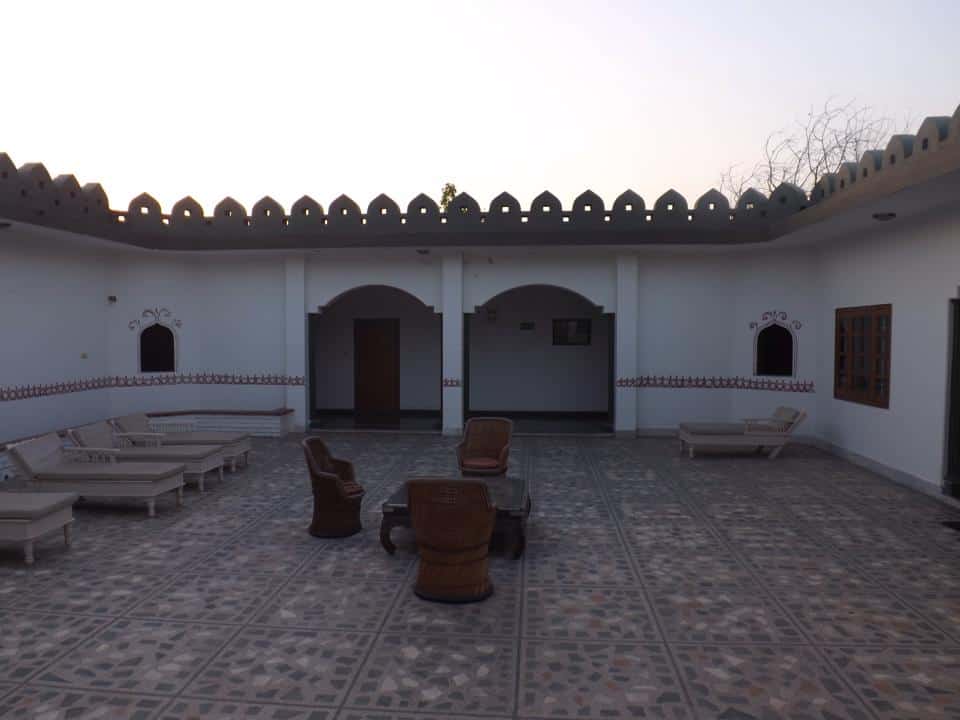 In the morning I was back at the buffet, this time for breakfast before hitting the National Park on the first of my three safaris. the spread this time leaned more towards western food and I appreciated the wide range of hot food. No naan theatrics in the morning though!
In the morning I was back at the buffet, this time for breakfast before hitting the National Park on the first of my three safaris. the spread this time leaned more towards western food and I appreciated the wide range of hot food. No naan theatrics in the morning though!
Safari One
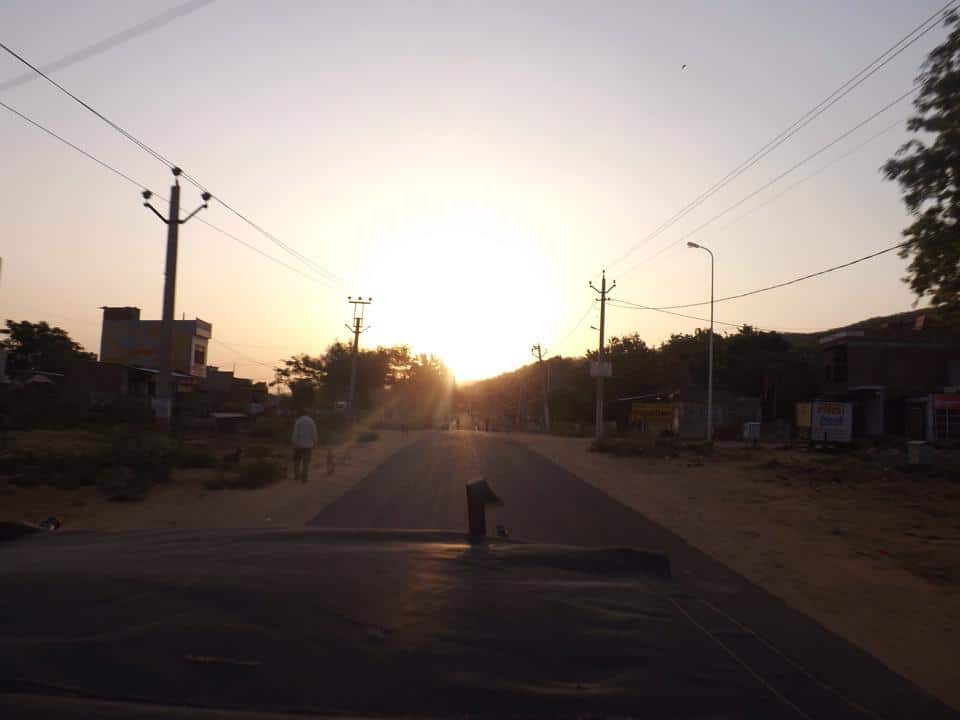
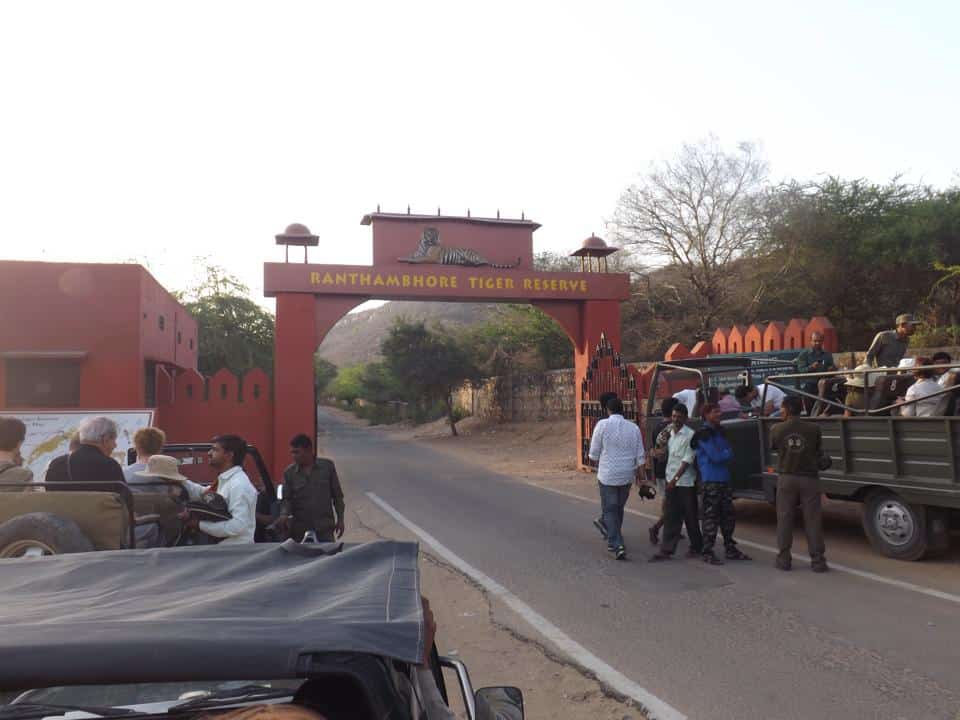
There’s a bunch of us at the hotel heading into the National Park for the safari and we halt at the gate until the full complement of gypsies and canters arrive. Once we’re all here we head into the park and split up along the different routes. We drive for a few minutes before we spot the first group of animals.
The animals have evolved a symbiotic relationship: the langur monkeys have superior sight and can climb the trees, dislodging fruit that the chital deer enjoy eating. the deer have superior sense of smell, so each warns the other of potential threats.
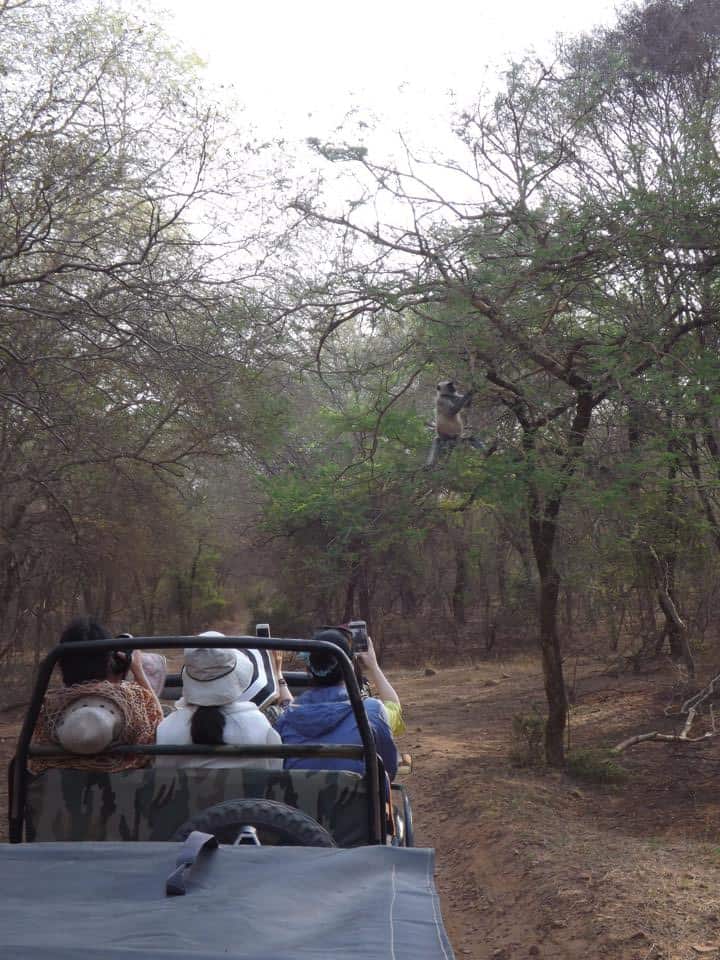
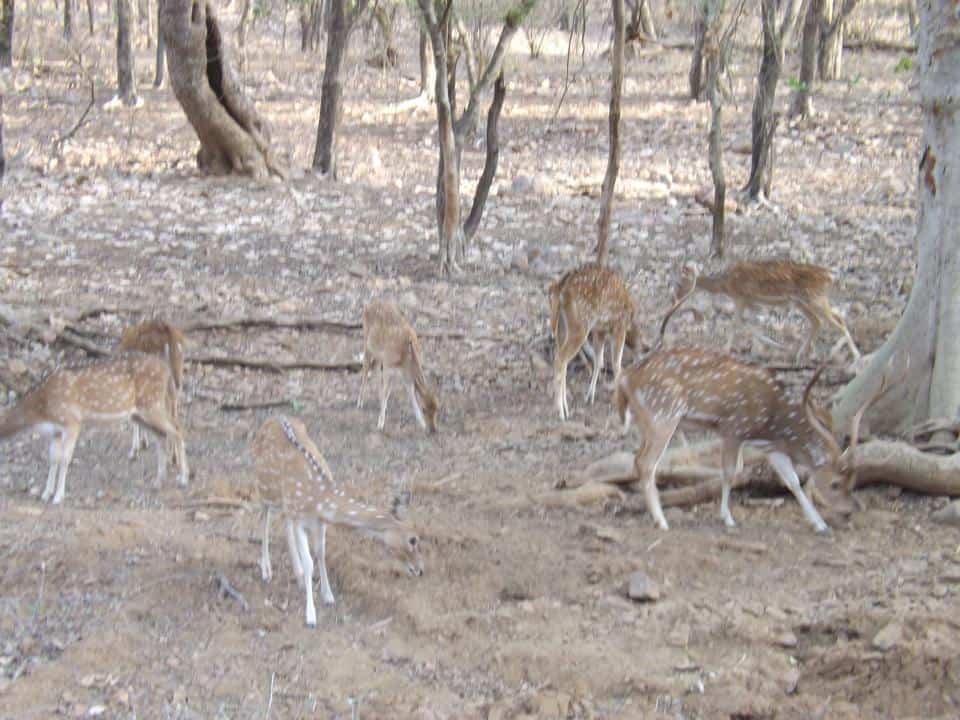
I’m actually just enjoying the drive – the sun isn’t too hot this early in the morning and it’s pleasant driving through the wilderness where the animals aren’t too concerned with our progress. We periodically stop for the guide and driver to communicate with others over the radio and occasionally one of the other jeeps passes us, or we pass one as they pull off the path and peer into the bush.
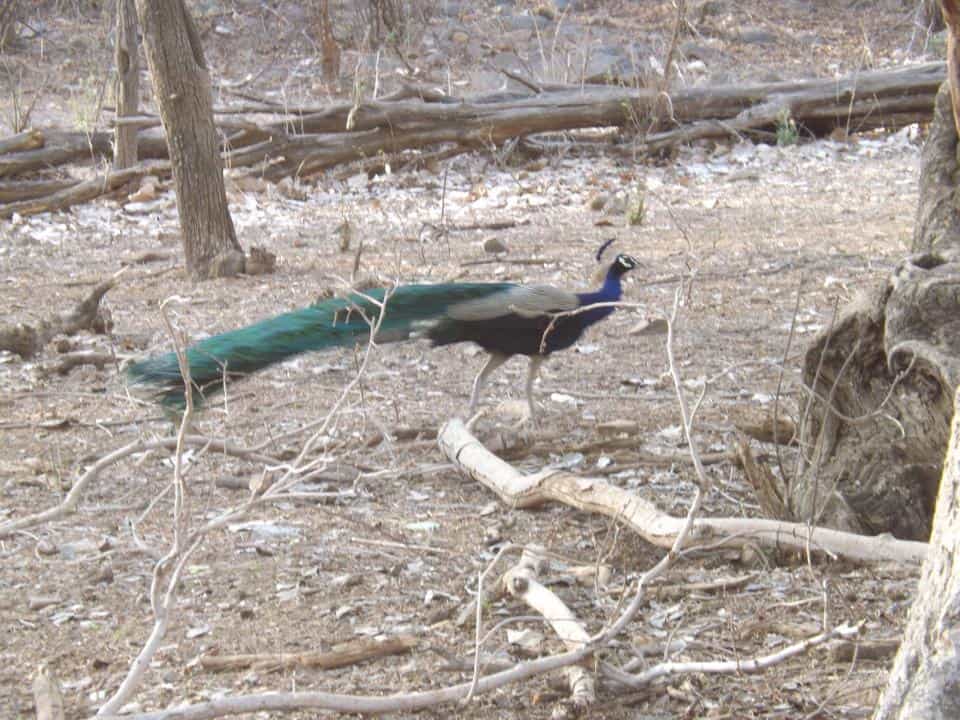
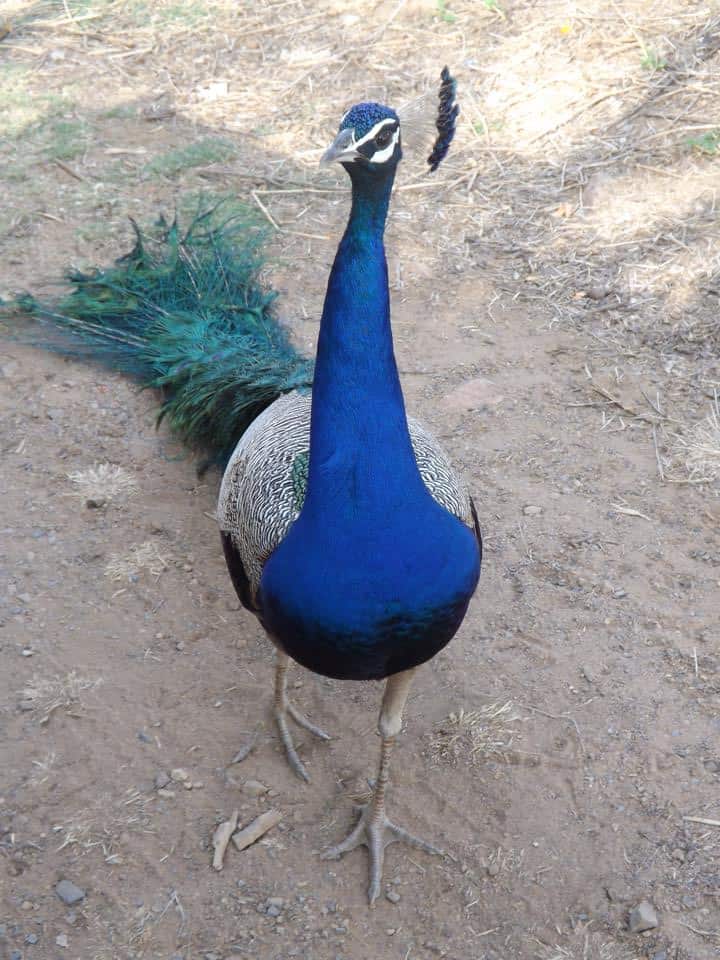
We’ve been driving for about an hour when the radio springs to life and the garbled voices say something which makes our driver and guide attentive. We move forward with a bit of urgency and see another jeep on the side of the road with everyone peering intently over the riverbed into the low hill beyond.
There, laying amongst the branches of the shrubs is a Bengal Tiger. Before long we’re joined by all the other jeeps and everyone quietly oohs and aahs at the tiger. There’s a bit of jostling for position by the drivers as there’s only so much space so that everyone can see past the trees to where the tiger lies.
After maybe twenty minutes the jeep that discovered the tiger drives off and then a few moments later we do too. None of the other people in our jeep have been on a safari before so we’re blase about the sighting.
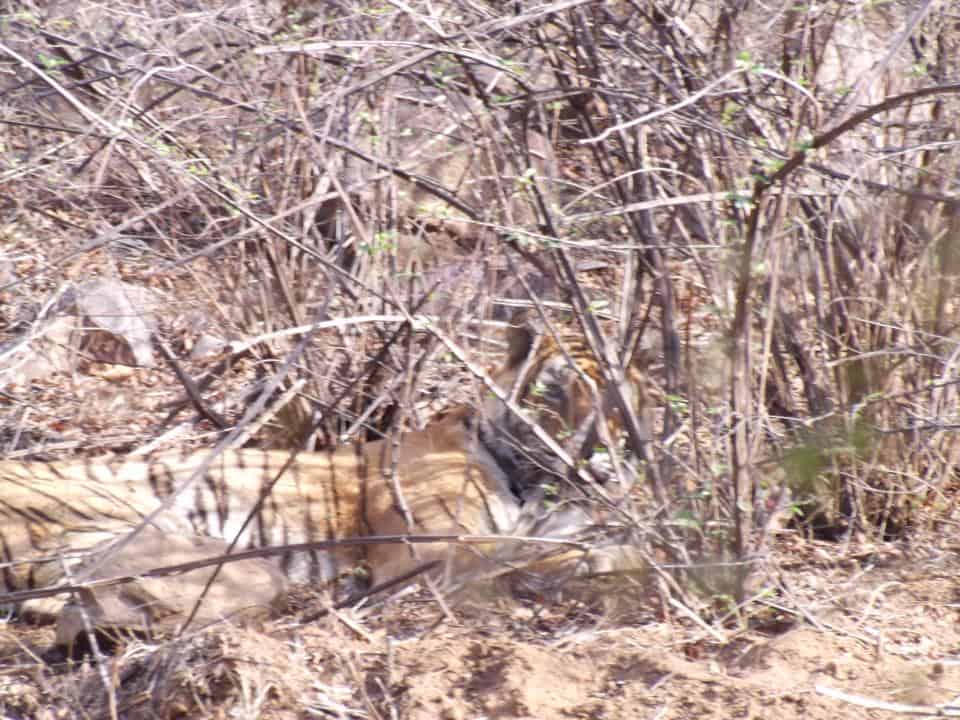
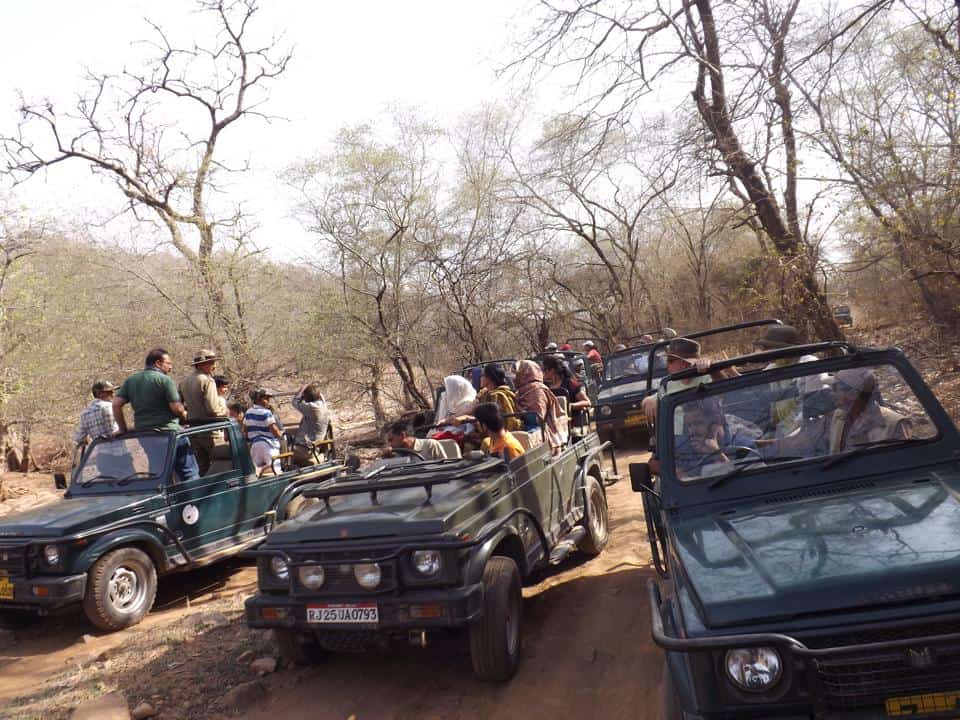
We head further along the route and before too much longer the jeep pulls up and the guide and driver excitedly point to the track. Even I can see the paw print of the tiger on the dusty part of the road. Presumably the tiger crossed the road after the other Jeeps went by. It gives me pause – could this be the same tiger that we previously saw – but the guide assures me that the route we have taken was more direct that the one that the tiger would have taken.
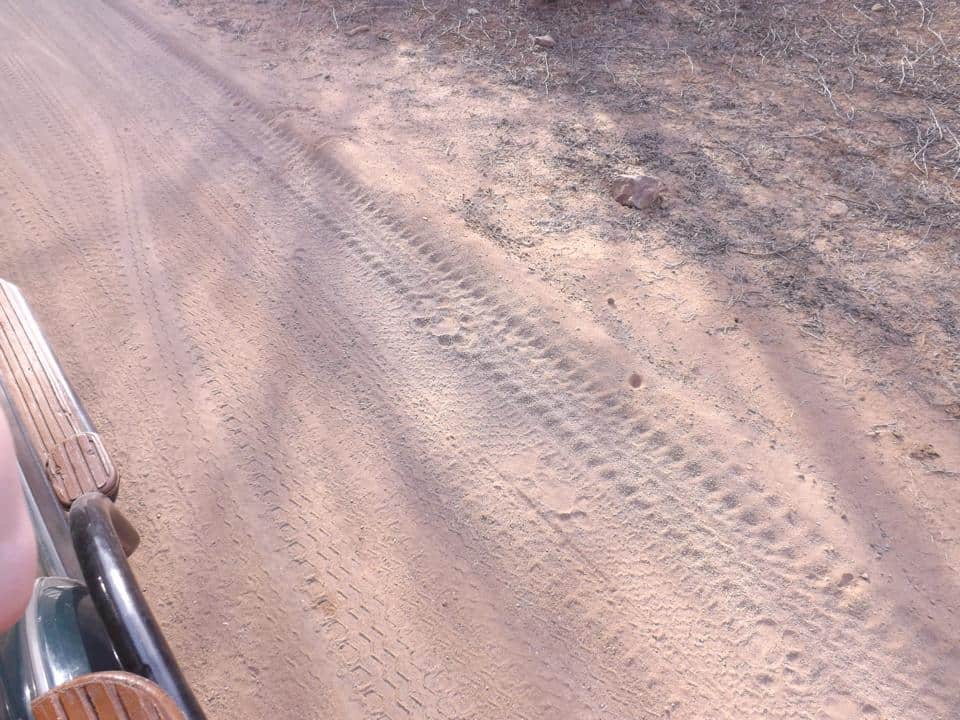

Not long after that we spot the new tiger in the brush. I’m a little confused – surely if it wanted to rest it would do it in the shade, and while its not in the direct sun, there are more trees elsewhere with more shade. And while its not yet ten, the sun is starting to beat down with more and more ferocity. I guess by noon it’d find itself a cooler spot.
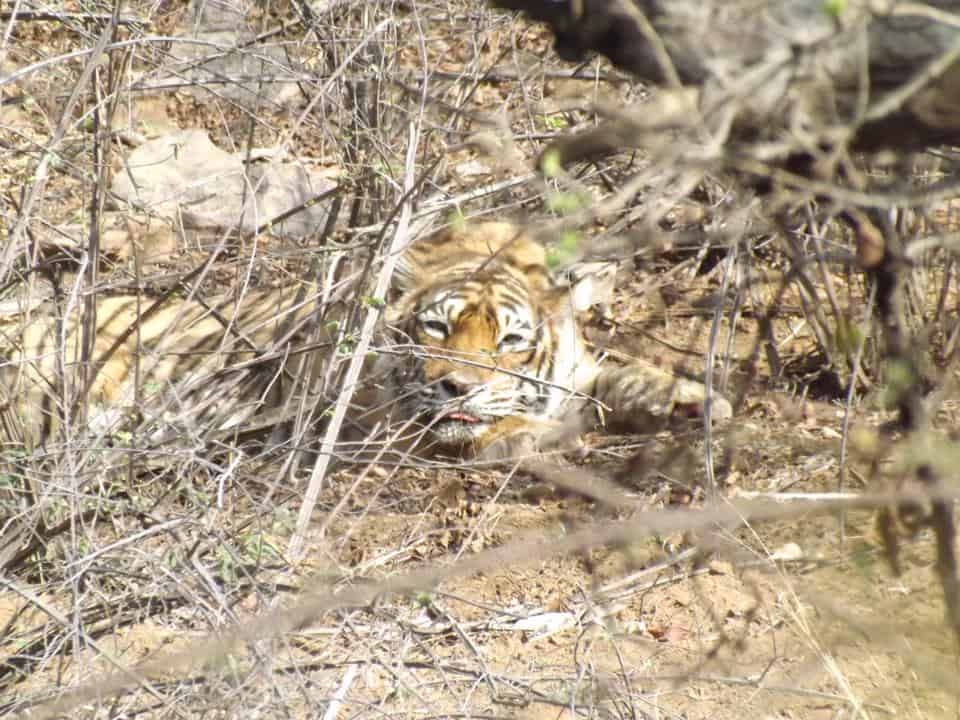
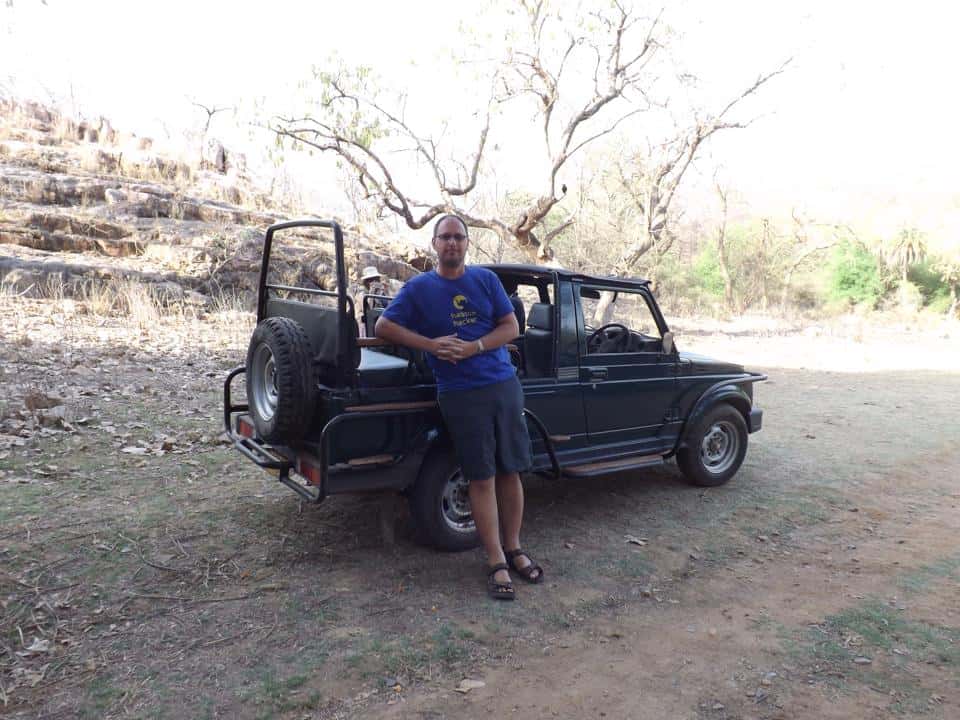
We pause on the way back out for a toilet break and the guide and driver seem giddily happy that we’d seen two different tigers. The rest of the passengers like me are happy to have seen them on our first time out, but there is a marked difference in the intensity of feeling. We get back to the hotel and the passengers thank the crew and disappear into the hotel. We have a few hours before the afternoon safari and I shower the safari dust and sweat off and have a nap.

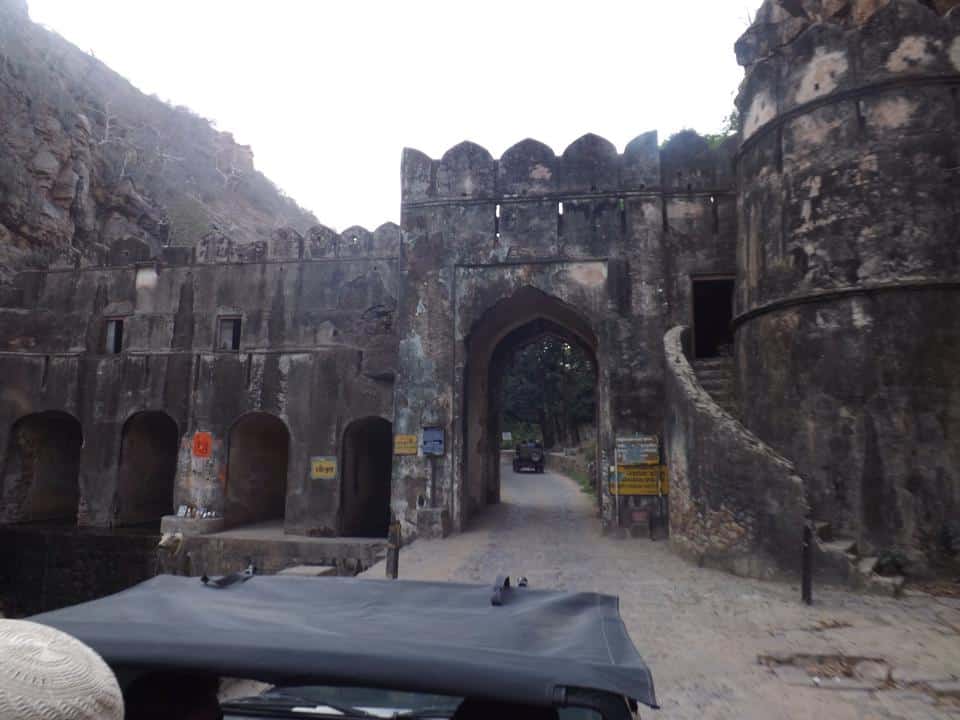
Safari Two
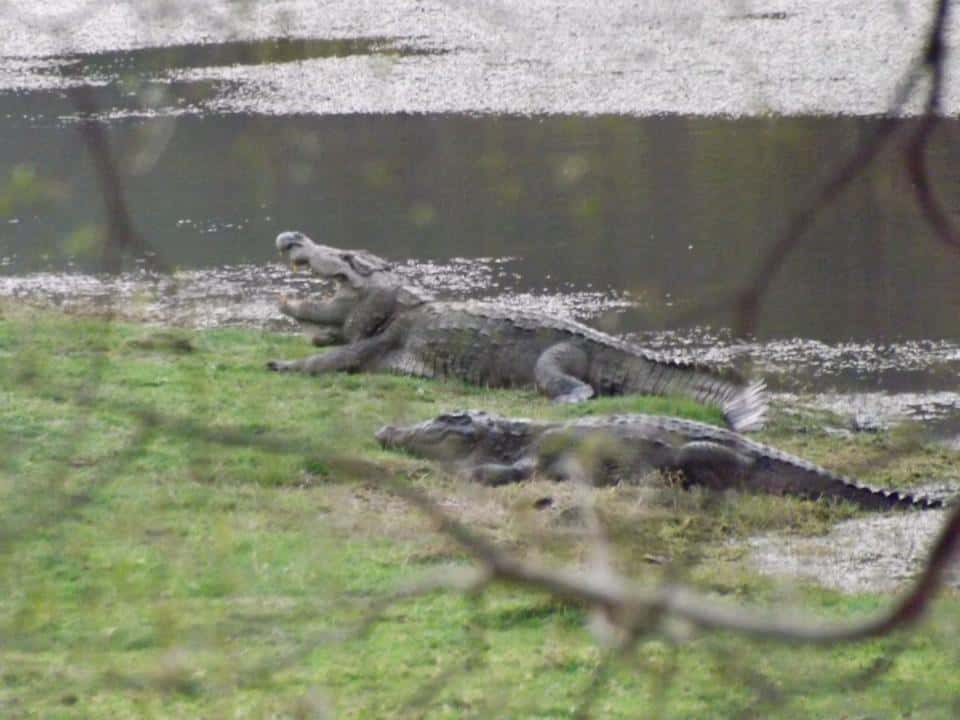
The afternoon safari sets out along a different route – while the first one was surrounded by dry brush and high canopy forest, this one is along rivers and lakes and a much more tropical feel. We again see the troops of monkeys living alongside the spotted deer, but this time they are accompanied by peacocks and larger deer. We also see crocodiles on the banks of the lake prompting a few jokes about the advisability of swimming in the National Park.
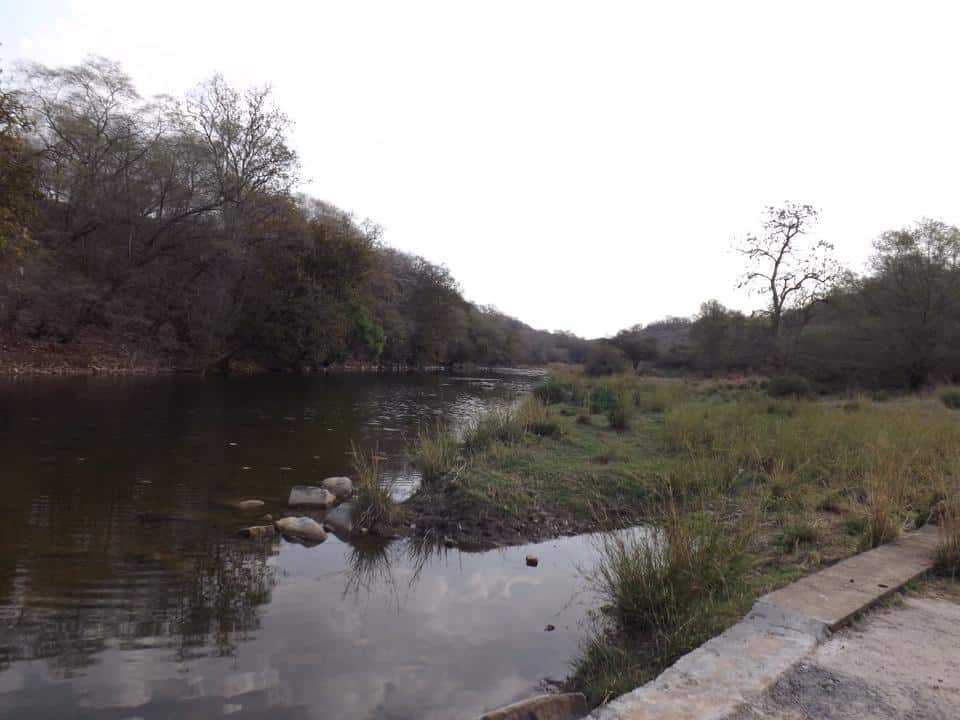
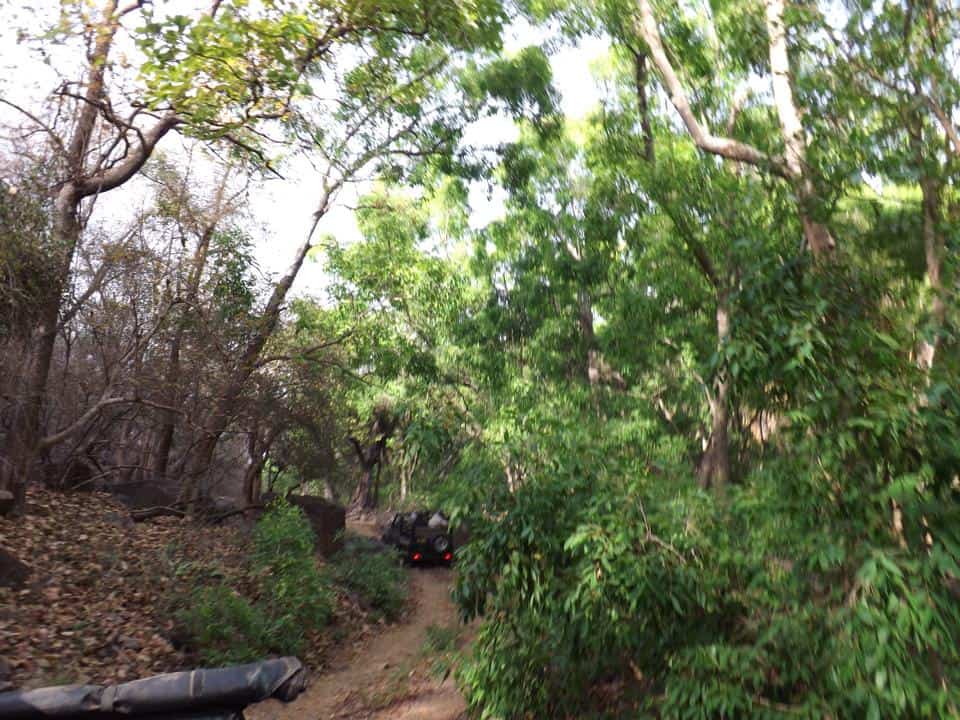 We pause with a bunch of other jeeps. Someone has found some peacock feathers and the consensus is that one of the tigers has taken a peacock. So four jeeps have converged at the spot and thirty pairs of eyes attempt to pierce the dense lush bush for some sign of the great cat. Time ticks by and hushed voices of guides and drivers are the only noises. After about half an hour, eventually, reluctantly we move on from the spot.
We pause with a bunch of other jeeps. Someone has found some peacock feathers and the consensus is that one of the tigers has taken a peacock. So four jeeps have converged at the spot and thirty pairs of eyes attempt to pierce the dense lush bush for some sign of the great cat. Time ticks by and hushed voices of guides and drivers are the only noises. After about half an hour, eventually, reluctantly we move on from the spot.
At the end of the route is a dam and a lake. We pause there awhile and my attention turns to my fellow passengers. In the front seat is an Indian gentleman in a sandy-tan safari suit and wide-brimmed hat. He’s quite short and has a camera with an enormous lens that matches his suit. The lens is seriously about half my height and must weigh a ton.
Each bench on the jeep takes three passengers and beside me is an Indian couple. I don’t know if they speak English so break the ice by nudging the guy, and nodding towards the super large lens and then back to my little lens and making a frowning sad face. He gets the joke and laughs and we make small talk for a while.
He and his wife are from the south of the country and had tried to come on the safari in the morning but hadn’t been able to get a seat because they were all booked up. I knew that the number of tourists allowed in the park was limited, but hadn’t made the realisation that you might miss out if you didn’t book ahead.
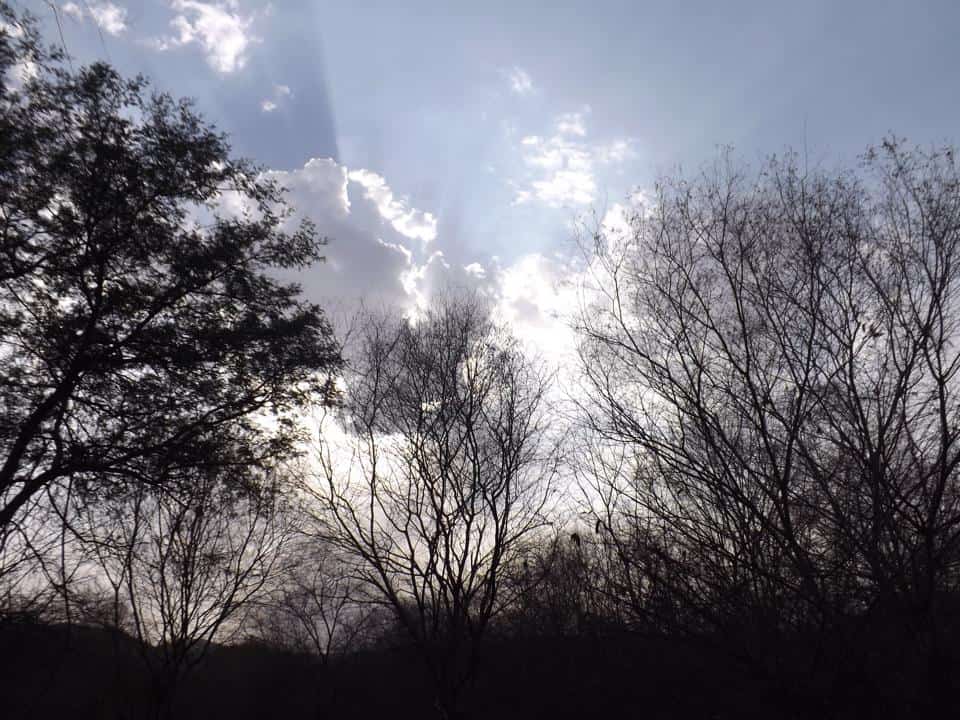

We head off and join up with the other jeeps at the entrance and it’s then that I realise just how much of a big deal it is to see a tiger.
So my friend had gone out three times when he was in India and didn’t see one at all. When I was researching, before I realised I couldn’t actually book from outside India, I had tried to see which zone was the most likely to have sightings based on the time of the year and whether the tigers had recently had cubs and when it had last rained. Exhausting. So it was a bit of a relief when I couldn’t make those decisions and the zone I went to was decided by the hotel. Or the safari permit people. Because I had no control, I realised that I had no influence on whether we saw a tiger or not and the only data point I had (my friend’s experience), indicated that it was incredibly possible not to see any tigers.
So my expectations were low. From the looks on the passengers in the other jeeps and especially on the face of the guy with the metre-long lens in my jeep, I realised that other people hadn’t managed their expectations quite as well. It really did look like we were at a funeral – sombre looks all around.
When we got off the jeep at the hotel, the Indian guy beside me said goodbye and I said it was a pity that we (indicating the passengers) didn’t see any tigers, which explained why we all looked sad, but I couldn’t figure out why the driver and guide looked so down.
Ah, said my friend, when they do find the tigers, the passengers tip very well – no tigers, no tip. My mind flashed back to that very morning when all the passengers (first timers remember!) had just got off the jeep and gone to their hotels without tipping the crew. And we had seen two tigers!! Ooops!
Realising how lucky I had been, on the way past reception I stopped by and had a word with the guy behind the desk. I let him know that I’d been lucky enough to see a tiger first up and thought my third safari spot would be better given to someone else to have a go – what else did they have for me to do the next morning?
He didn’t have to think too long before suggesting a trip to Ranthambor Fort. I’d seen the trip to the Fort on their website and coincidentally enough the cost for a single person was exactly the same as for the safari so I readily agreed.
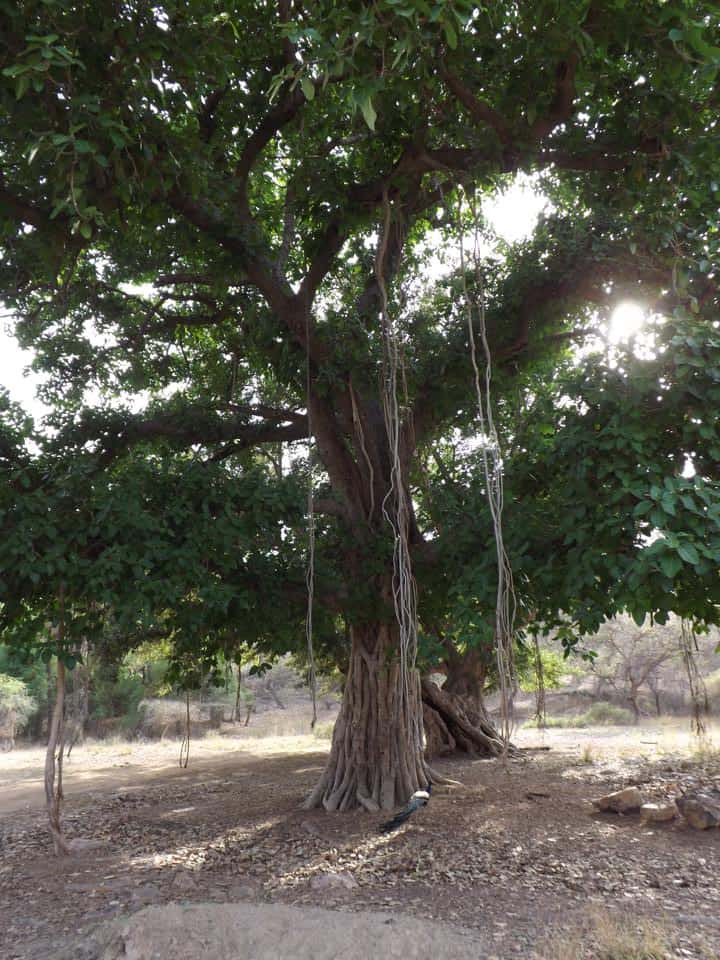
The Fort
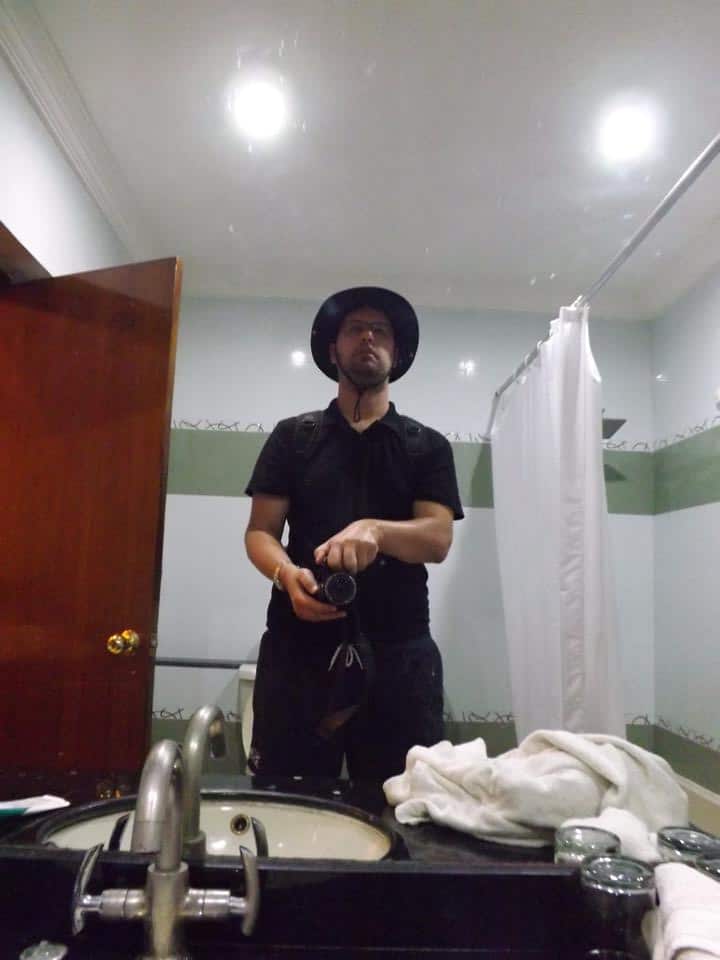
I got up and breakfasted at dawn the next day ready for the trip to the Fort. I was in good spirits because I had ticked off the four things I wanted to do on this trip and now anything else was going to be bonus territory. I met my guide and we set off in a jeep but parked not far from the entrance to the park. I soon saw why – a steam roller blocked the road ahead.
Apparently they didn’t want cars driving over the area that they were paving. I was happy enough strolling along beside my guide in the cool morning air. Occasionally a moped would nip by – always with a passenger on the back.
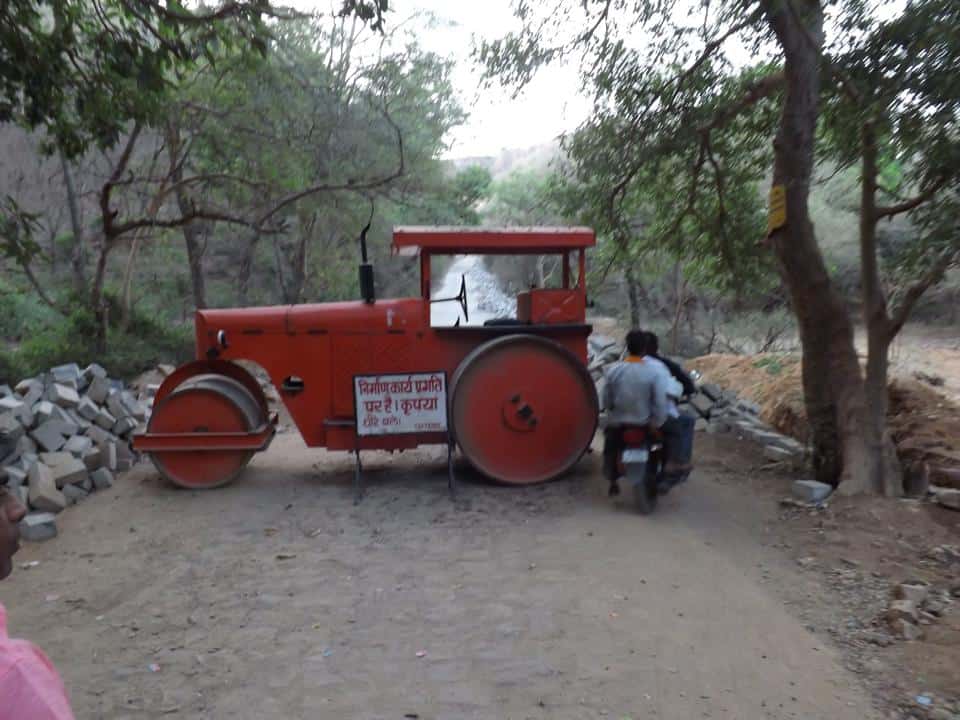
I asked my guide why there were so many people heading up to the Fort. He smiled and said that there was a famous shrine in the Fort and that this was a holy day: Akshaya Tritiya. I try and memorise the name but have to look it up later.
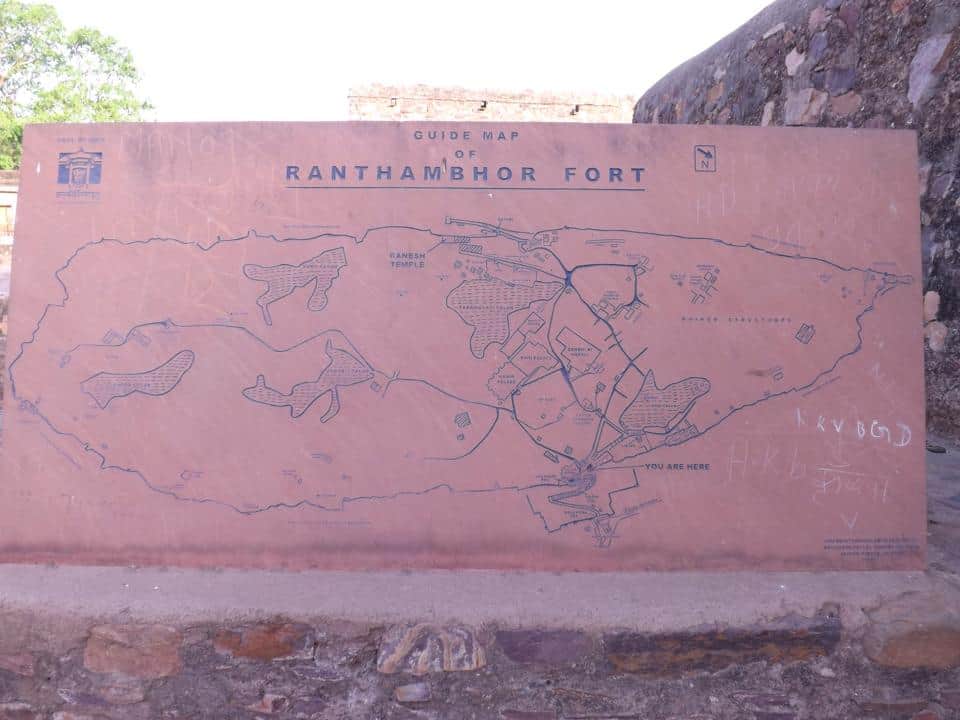
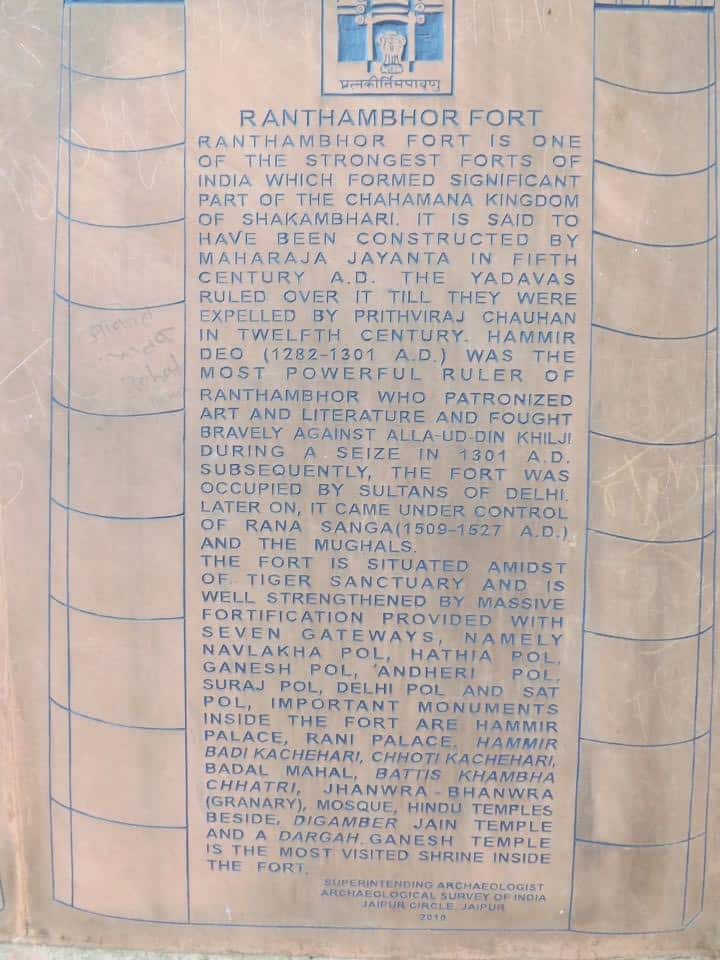
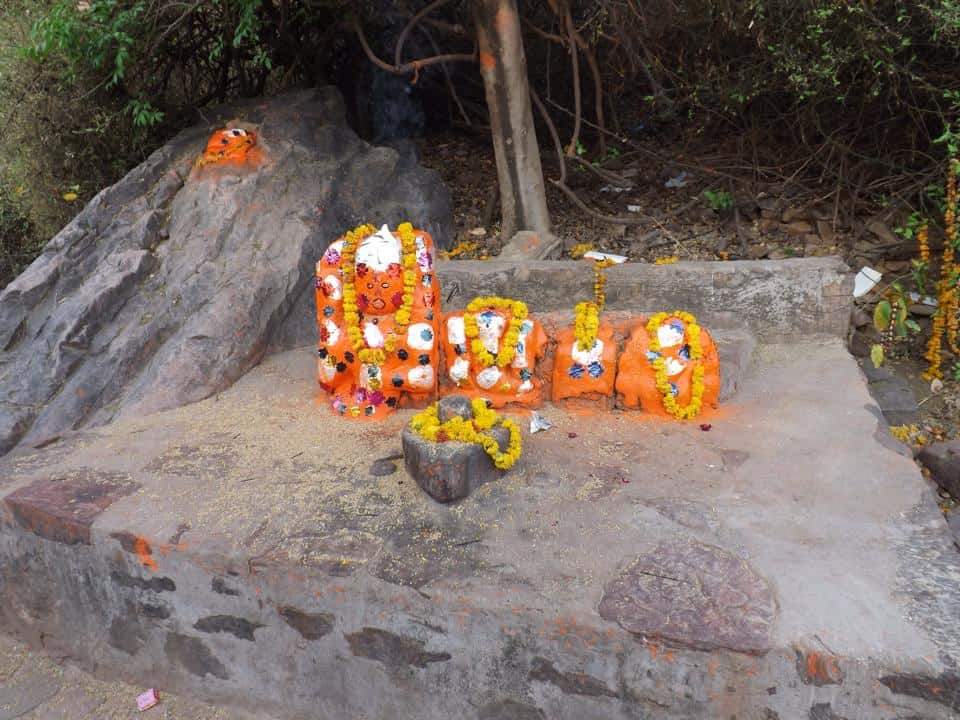
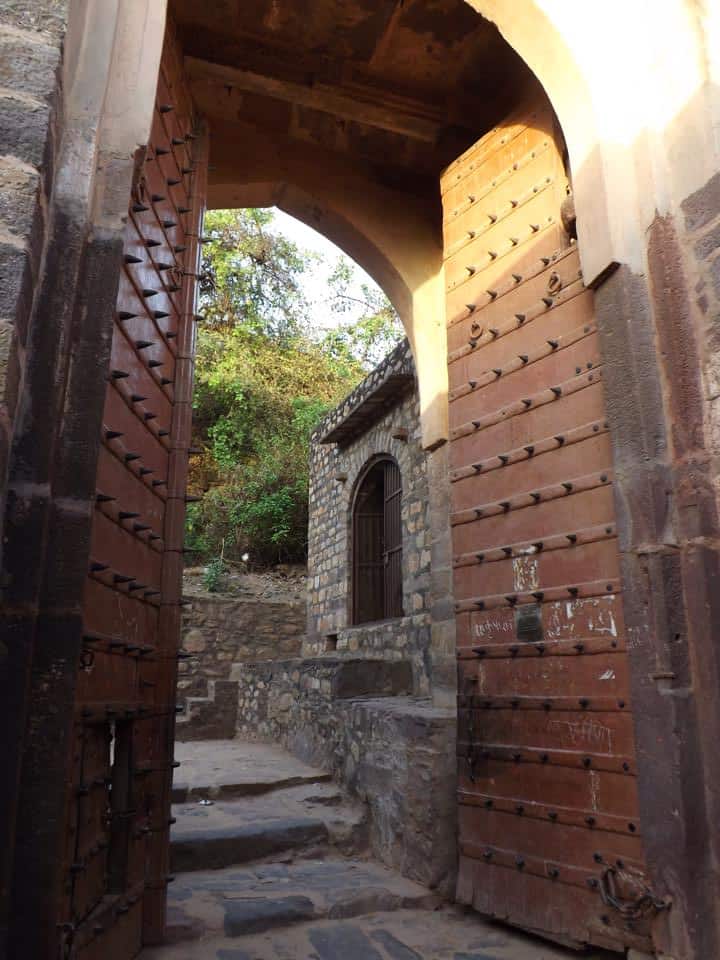
We make it to a bunch of buildings at the base of the Fort and begin the walk up. I learned in Agra at the Fort there that the favourite form of breaking down the gates on forts during sieges was to get an elephant to take a run up and bash them down. So that the more well designed forts have simple methods of countering that – things like curves before gates so that elephants can’t build up speed before hitting them. 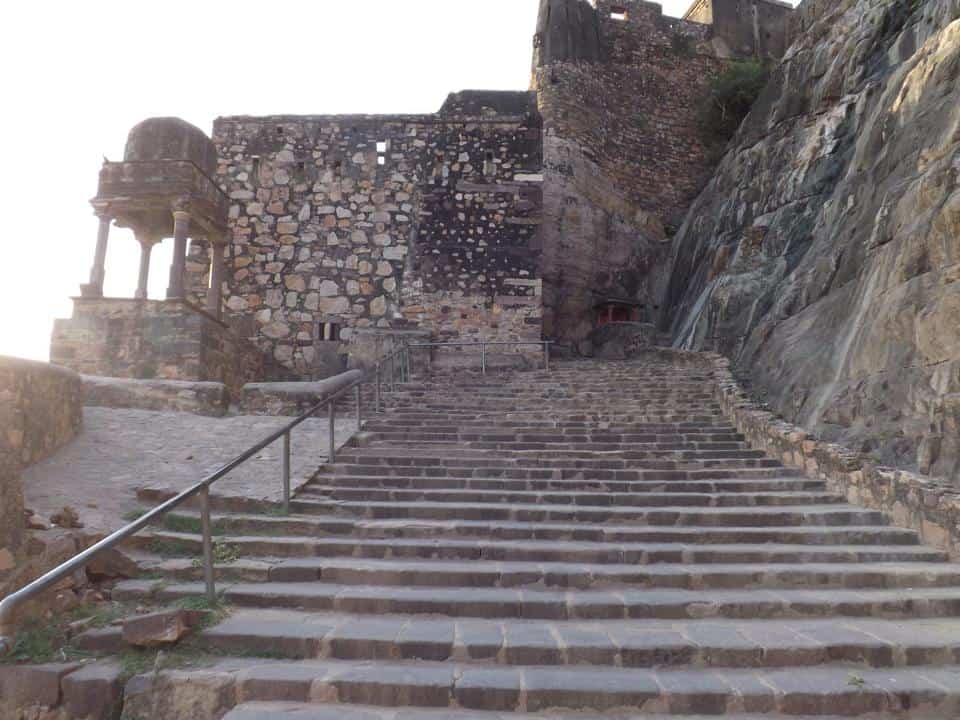

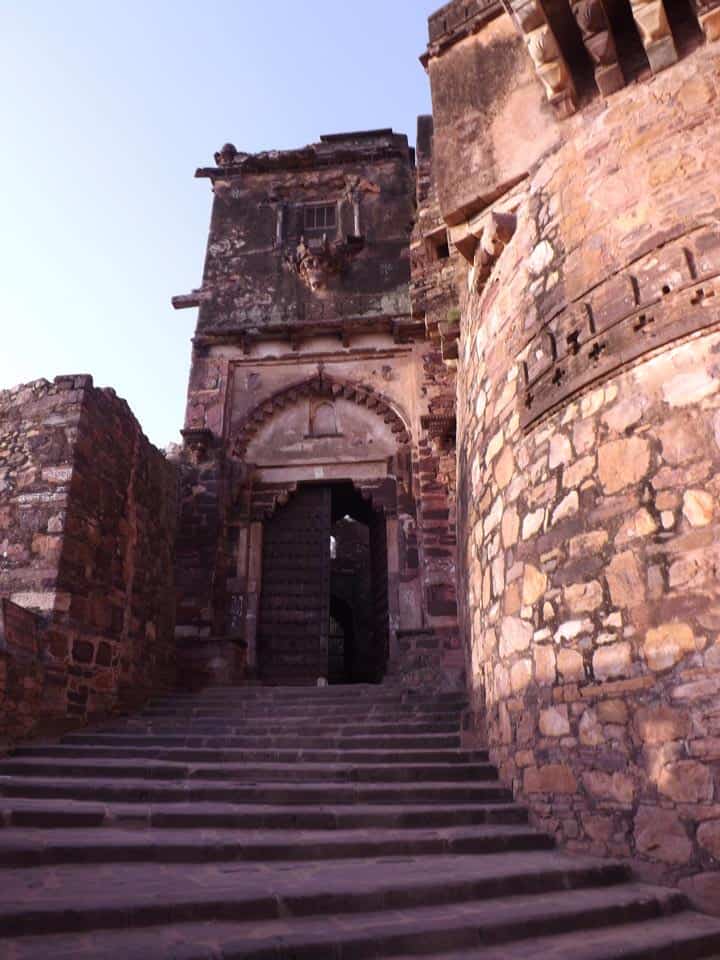
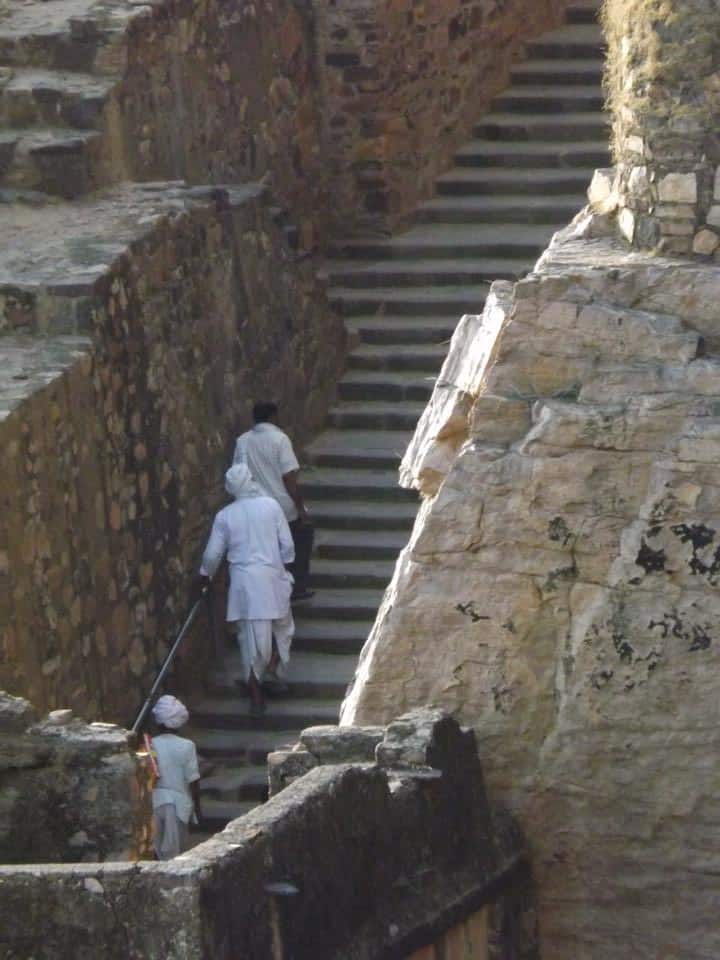
The stairs switch back on themselves and below I see pilgrims beginning the ascent, all heading to the Temple. I ask a few questions about the holy day and apparently it is an auspicious day to start new things, to buy property or gold.
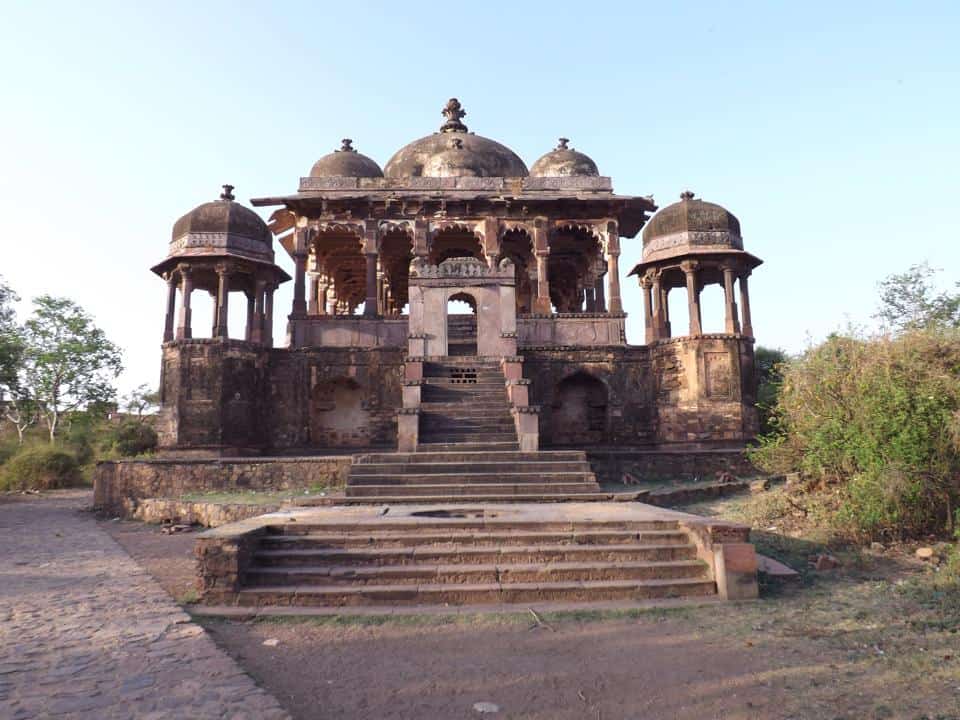
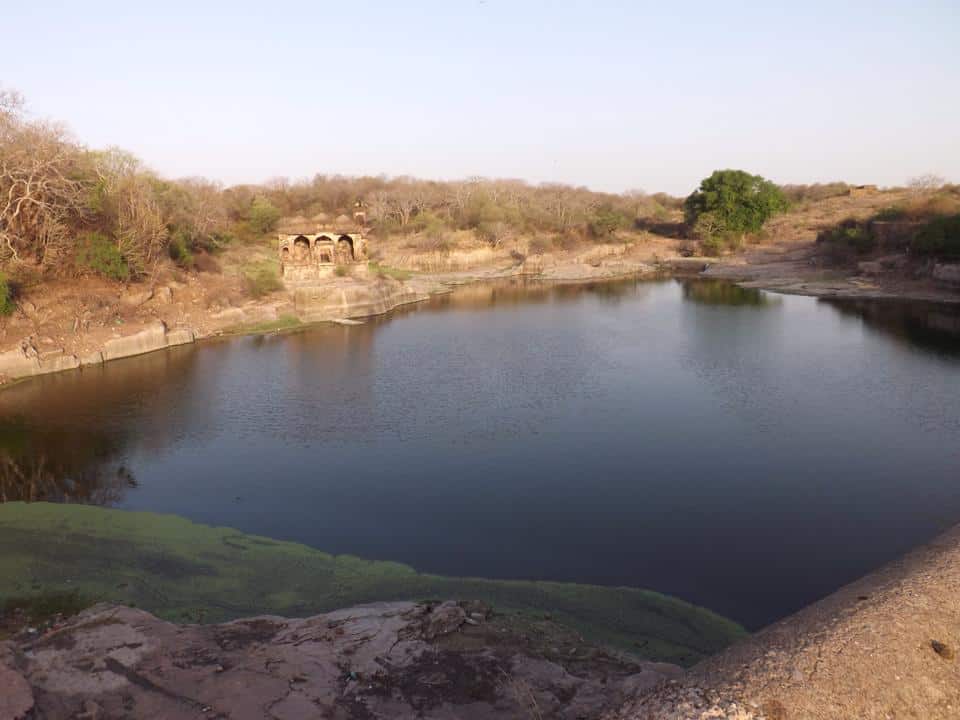
The plateau that the Fort sits on is huge – the lip of it is well defended with thick walls and there are many ponds or lakes at the top, making the Fort incredibly defensible. There are temples to Ganesh and Kali as well as a Jain Temple and a Mosque. It’s amazing that the Fort has served so well for so long through history – testament to the natural barriers to conquest.
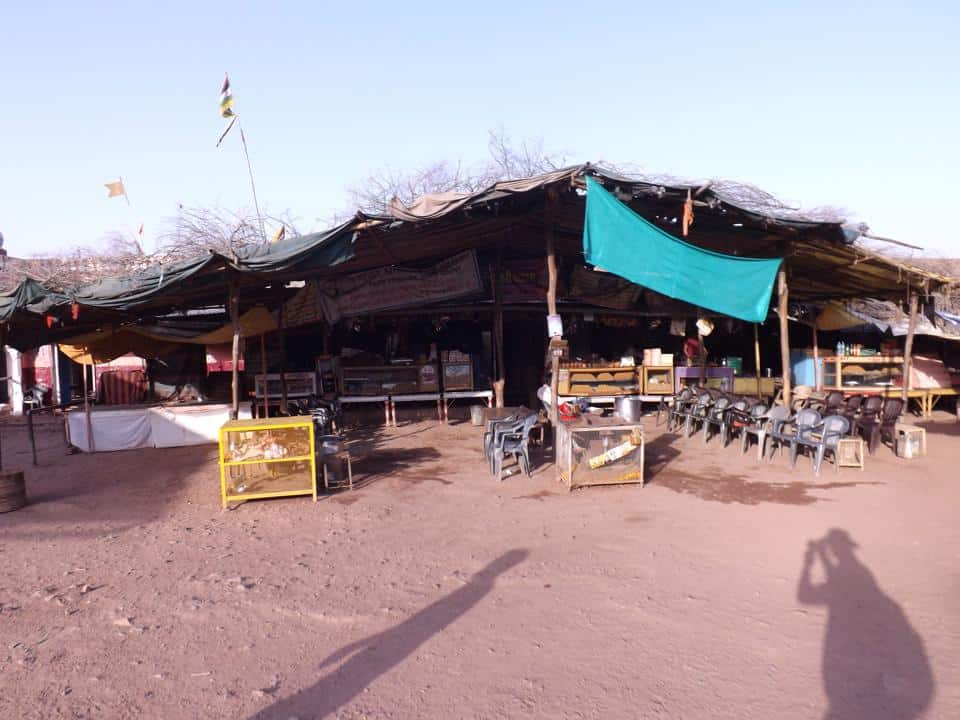
Once we get to the Temple of Ganesh, my guide invites me in. I doff my hat and put the lens cap on the camera and head in. A crowd is lining up at barriers not unlike sports stadium concession stands and slowly move forward to receive the blessing of a brahmin. My guide indicates that I can go forward for the blessing if I like but I demur and just take in the sight.
There’s a general murmuring between recipient of the blessing and those blessing and then a mark is made on their forehead. Finally the recipient gets or buys a small hand size square of cake and then leaves. My guide and I leave and he offers me a small section of the cake. I try it – it’s nice enough.
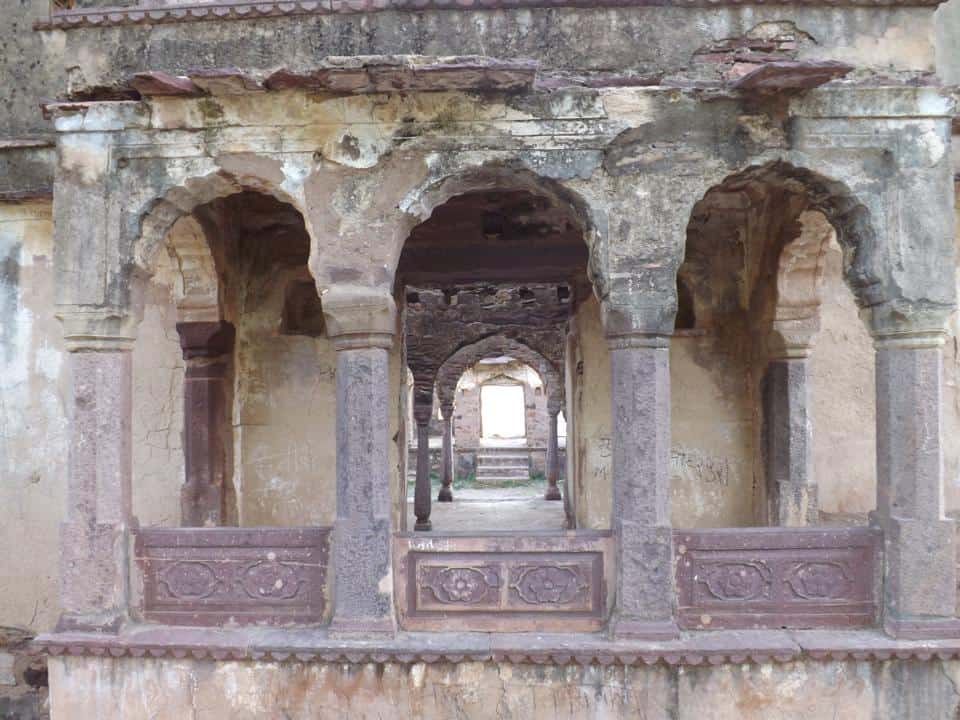
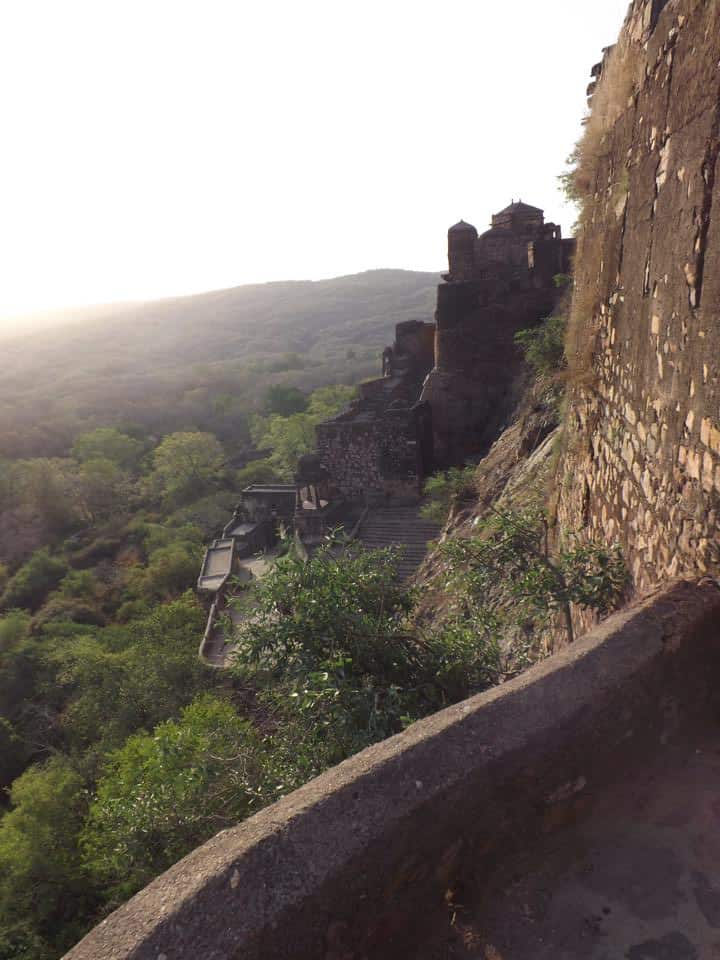

On the way back down my guide tells me of a story about the lake. Many years ago he says that the lake actually dried up. For the first time in centuries. The crocodiles that lived there all had to move on to find water and so the roads were covered in literally hundreds of crocodiles all trying to find enough water to live in. Then the next year the rains came and the lake refilled, and so the crocodiles all walked back. He grins and says the moral of the story was that crocodiles are resilient creatures. I retort that I think the moral is to swim at the pool in the hotel. He laughs.

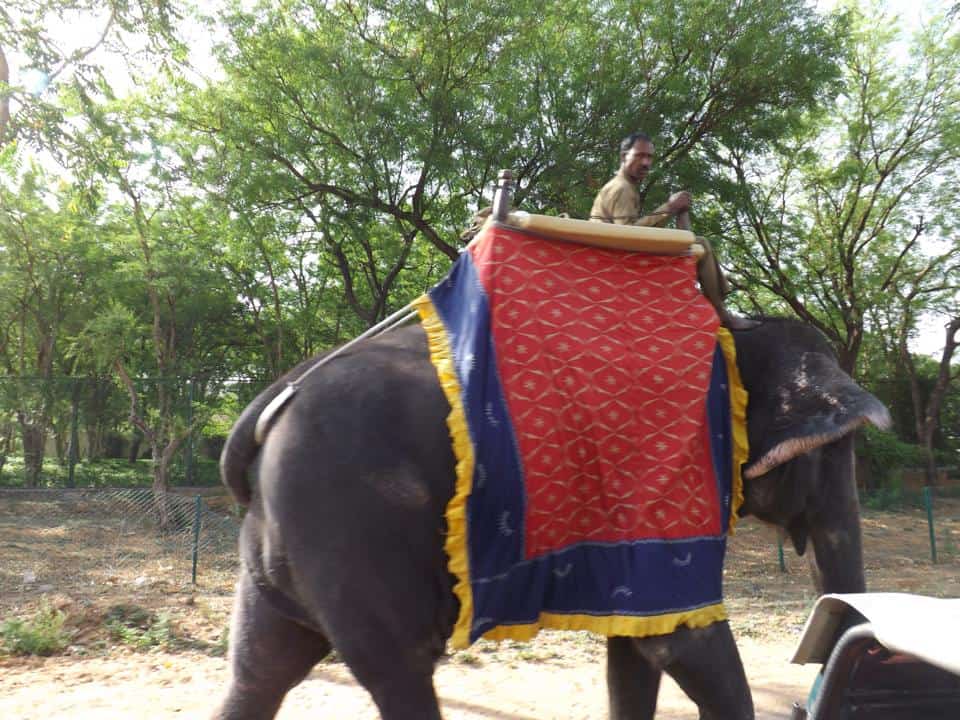
So we head back to the hotel, and everyone we meet of the staff comes up to my guide and he shares a little corner of the cake he got at the temple. He sees me watching and explains that he is sharing the luck that comes with the blessing which strikes me as being an awesome approach. Before long it’s time to be picked up by my driver, so I go to pay the bill.
The owner makes a point of coming down – he wants to say goodbye and thank me for staying which is a nice gesture, and this certainly impresses my driver. I try to pay using my credit card and for whatever reason the machine isn’t working, so the owner despatches one of his staff to accompany me to the nearest ATM in town to get out the remainder that I owe them (I had had to pay a USD100 deposit to secure the booking).
I’m surprised by this until I’m told that the credit card machines use the cell network and that if the local cell tower has too many connections, it can’t add additional ones and so therefore the credit card machine can’t connect to the banking network. I’m glad that the ATM in town works and I’m super alert for skimmers on the machine or people standing too close to me. I make a point of handing the staff member the money in front of my driver so there’s a witness that I’ve paid and then we leave him to walk back to the hotel and we head off to Jaipur.
Would I go back?
I loved the Ranthambore Regency. I loved the fact that they charged me what the government charges them for the entry to the Park. I loved the food and the theatrics of the naan baker. I loved the fact that it had a pool and the rooms were large and the bed comfortable. But what I liked best was something that they had no control over – I loved that I saw a tiger. Two tigers. I’ve done that now though, so it unlikely I would return. If I wanted to do another tiger safari though, I’d start and end my search with the Ranthambore Regency.
Previous: The Step Well at Chand Baori | Part of Trip: Pollution & Tigers | Next: Jaipur

